Continued from Highland Park, Part 1
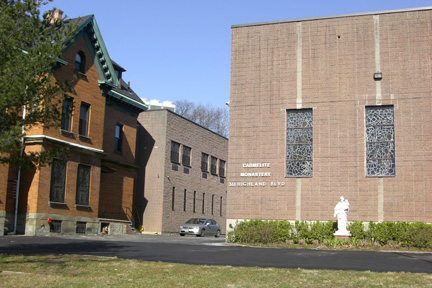
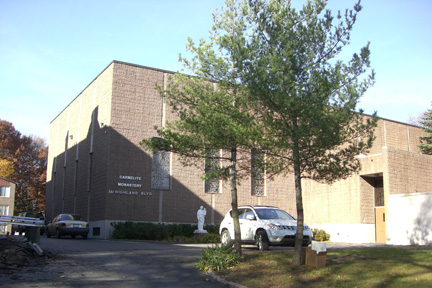
Turning the corner on to the vestigal path known as Robert Place and striding back to Highland Boulevard, we find an answer familar to all Nick Cave fans, and numerous others: God is in the house. This facility is home to the Discalced (i.e., barefoot or with just sandals) Carmelite Sisters. According to the Diocese of Brooklyn, the Carmelites were founded in Spain in 1562. Quite obscure even to Catholics, this intensely contemplative order is best known via Francis Poulenc’s strange and brilliant 1957 opera, Dialogues des Carmelites. The Sisters’ previous Brooklyn home, at 745 St. John’s Place in Crown Heights, closed in 1997, its members dispersing worldwide. The monastery was built as a Lithuanian community center in 1974, although other buildings on the property — including a mansion home to Lithuanian Franciscan priests and a three story brick rowhouse housing the offices and printing press for the former Lithuanian weekly newspaper, “Darbininkas” — predate the 1974 building.
Highland Mansions
Heading west on Highland Boulevard, we begin to come upon the large homes which some called mansions. While many of the houses are substantial, and handsome in their respective styles, compared to recent construction in Midwood and, especially, Mill Basin, the architecture here is are relatively demure.
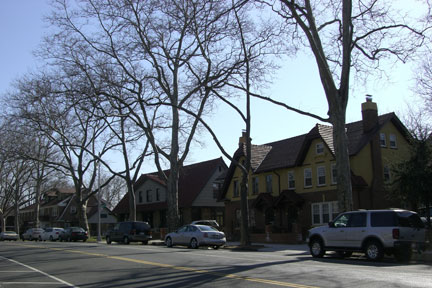
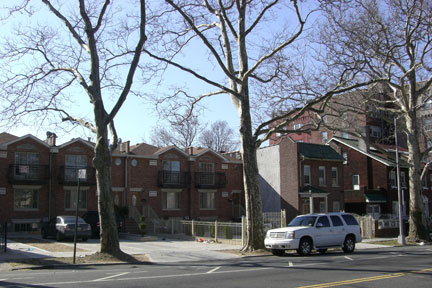
The mix of buildings on the south side isn’t nearly as remarkable although the views still impress, especially in winter.
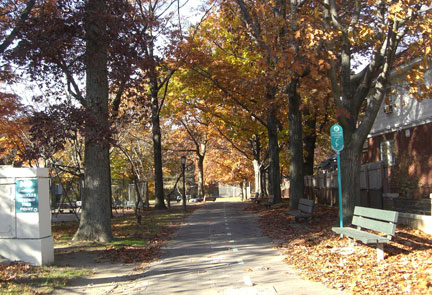
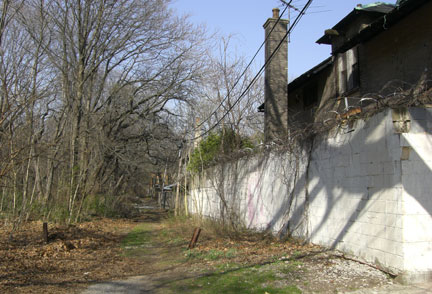
Heath Place is an oddity. Today its yet another entrance to this part of Highland Park. In the past, it was also the short road to the abandoned Robert Street. While a chronology of Highland Park the park is for another time, now itís important to know just two things: first, this area was not part of the original Highland Park, and second, as a neighborhood, it was not universally called Highland Park. Even today, newspapers — presumably echoing the 75th Precinct down on Sutter Ave — will sometimes refer to local crimes as happening in East New York or Cypress Hills. To 19th and early 20th century Brooklynites, things were even more confusing: welcome to Ridgewood Heights, named after, of course, Ridgewood Reservoir and including, just below it, Ridgewood Park.
Difficult as it might be, none of these are to be wholly confused with Ridgewood in what was nearby Newtown, Queens County. Similarly, the private Highland Park there — popular in the 1880s for its rollicking German Volkfests — shouldn’t be mistaken for the Highland Park of today. Forgotten by nearly all save a few baseball historians, Queens also had its own Ridgewood Park, just over the county line from Bushwick where — get ready — the Brooklyn Grays (later Bridegrooms) of the American Association (later the Brooklyn and Los Angeles Dodgers) played in 1886-1889. If the massively tangled byways of borderland identity are your bag, have at it, Slugger: Wallace’s Grounds, Meyerrose’s Park and the Horse Market Grounds were all names used by contemporary journalists reporting from Ridgewood Park. (Be grateful the city did settle upon on the name Highland Park.)
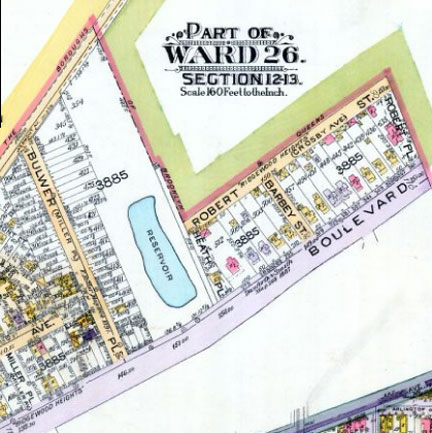
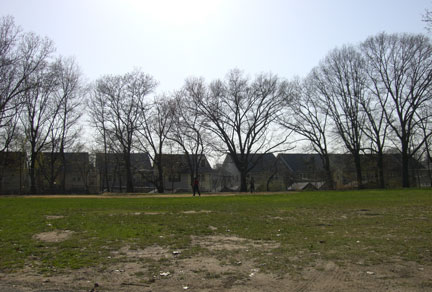
Back in the present, it’s fair to say that approximately nobody standing at Heath Place and Highland Boulevard would guess that, where kids are shoot hoops, bike ride, play baseball and whatnot, was once… a reservoir. But not Ridgewood Reservoir! That was built for the benefit of Brooklyn and, even after annexation, the residents of New Lots were not connected to the Ridgewood water works system.
Instead, when wells were no longer sufficient for a growing population, the private (with a New York State charter) Long Island Water Supply Company was formed to distribute local groundwater to the 26th Ward. Its pumping station was on Fountain Avenue down at Spring Creek and its reservoir was here, about about 150 feet above sea level. Ironiclly, before it was built in 1883, the site was even higher but a wooded hill was leveled so excavation of the basin — measuring 600 feet long, 200 feet wide and 20 feet deep — could begin.
In a pattern all too familar today, although lauded upon its opening as “one of the most complete and perfect systems of water works of any town in country,” the Long Island Water Supply Company was soon mired in scandal. The catalyst for this affray was the proposed 1890 purchase of the system by Brooklyn (remember, New Lots was its own municipality when the system was built) for what many deeemed an outrageous price. The Eagle, for one, went mad dog, publishing scathing stories on the shoddiness of the New Lots water works, as well as questioning the tangled connections between the companyís board, Brooklyn Mayor Alfred Chapin and the legislature in Albany. In any case, after the sale was finally effected, New Lots’ mains were hooked up to the Ridgewood system, the land sold to city and added to Highland Park.
A Lot of Bulwer

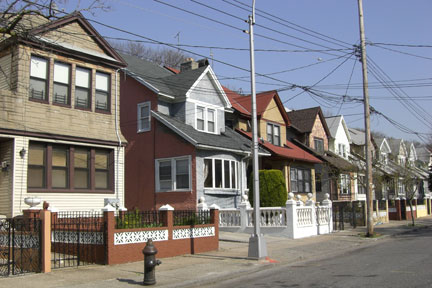
Out of the water and into the streets, we arrive at Bulwer Place. Although some have claimed it honors British diplomat Sir Henry Lytton Bulwer (1801-1872), best known as co-sponsor of the Clayton-Bulwer Treaty of 1850, which tamped down competing U.S. and British interests in Nicaragua, I don’t believe it.
While this unsatisfactory document was in turn-of-the-20th century news as it related to plans for the Panama Canal, that’s quite obscure, and why would theEnglish side of a fifty-year-old imperial dispute be recalled in the 26th Ward of Brooklyn anyway? No. A far more likely namesake was Henry’s brother, politician and novelist, Edward Bulwer-Lytton (1803-1873), known to most simply as Bulwer. Despite the mockery Bulwer’s reputation has suffered due to the infamy of “It was a dark and stormy night…”, which begins Paul Clifford (1830), Bulwer was enormously popular in both life and death, with Brooklyn booksellers advertising his works alongside those of slightly younger Victorian contemporaries Dickens, Thackeray and Trollope. For a level-headed view of Bulwer’s achievements as a crime writer, Julian Symons’ Mortal Consequences (1973) is highly recommended. Meanwhile, I hope a 1852 New York Sun item titled “News Boys Wit” pleases the skeptics:
A gentleman crossing one of the New York ferries was accosted by one of these peripatetic vendors of cheap literature and weekly newspapers, who are to be found in shoals about all public places, with “Buy Bulwer’s last work, sir? Only two shillin’.” The gentleman, willing to have a laugh with the urchin, said “Why I am Bulwer myself!” Off went the lad, and whispered to another, at a little distance, exciting his wonderment at the information he had to impart. Eyeing the pretended author of Pelham with a sort of awe, he approached him timidly, and, holding out a pamphlet, said modestly, “buy theWomen of England, sir? You’re not Mrs. [Sarah Stickney] Ellis are you?” Of course, the proposed sale was effected.
Bulwer Place runs north for two blocks before terminating at Vermont Street. Neither grand nor bedraggled, the mix of homes here is rather like one of those middle-class Brooklyn idylls that some say don’t exist anymore. In fact, while Highland Park has never, in its post-agricultural century, been static, neither it nor adjacent Cypress Hills suffered like some — but not all — other parts of East New York, numerous blocks of which share a similarly modest but well-kept appearance. One thing here that is quite unusual is a light pole (lower left) festooned with auto racing stickers, a public display of sporting enthusiasm this reporter doesn’t recall seeing in Brooklyn previously.
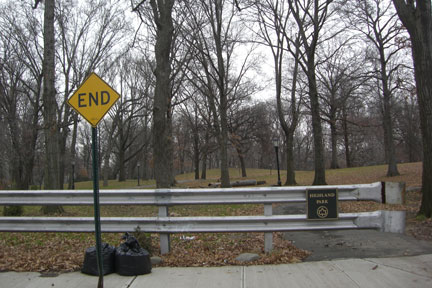
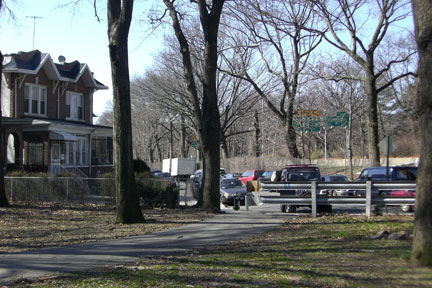
At the corner of Bulwer and Vermont, turning right quickly brings one to yet another entrance to Highland Park; turning left, we’ll begin our descent back to Jamaica Ave, gently at first. Under different circumstances, Vermont Court might arouse a greater amount of suspicion: an off-kilter dead end in an out-of-the-way spot, is it the vestigal remains of something? A small white, wood frame house with a porch mid-block is especially evocative but I don’t believe there’s any great puzzle here. Vermont Place was just a way fitting more lots into an odd shaped piece of land.
With traffic on the Jackie Robinson — née Interboro (constructed 1933-1935) — Parkway whizzing past, this tour gathers speed too. As the hill steepens, the homes on Vermont have been set in various ways to accomodate the land. My favorite among these is a gray, two-story wood frame house on an unusually large, grassy plot. Given developmental pressures in Brooklyn, one always wonders about anomalies like this, although, for now, no answer is forthcoming.
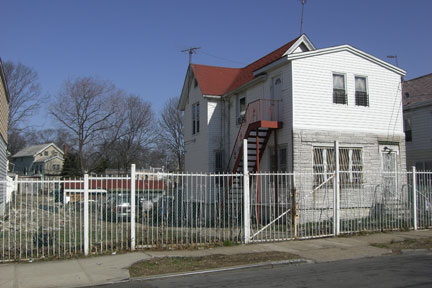
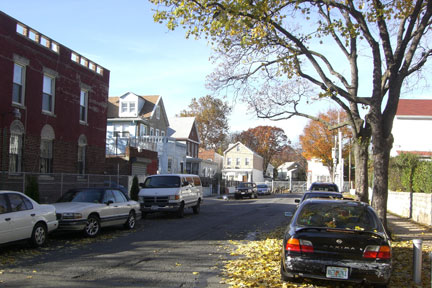
Crosby Avenue is named after one of the 19th century families in this area — no surprise here — and runs back to Bulwer, bisected by the one variegated block of Miller Avenue that crosses over the hill. As elsewhere, Crosby features a motley, and mostly handsome assortment of homes, most dating from the early decades of the 1900s. Where Miller ends at Crosby is another large lot with a small house upon it, creating a quite refreshing sense of space and wonder here. As the home has obviously been expanded over the years, is there any chance this was once a late 19th-century farmhouse? I suspect not, although it must be noted there’s much research yet to be done on the late- and immediately post-agricultural areas of Kings County.
Vermont Viaduct
As Vermont bends southerly, we gaze downhill at one of the little known engineering marvels of all Brooklyn: the Vermont Street viaduct, completed in 1897.

Surprising as it may seem, the bridge is historically linked to the Brooklyn road system that includes both Ocean and Eastern Parkways and is contemporary with the construction of the heretofore puzzling Eastern Parkway Extension (which begins at Ralph Avenue).
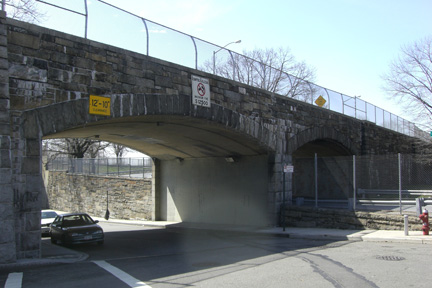
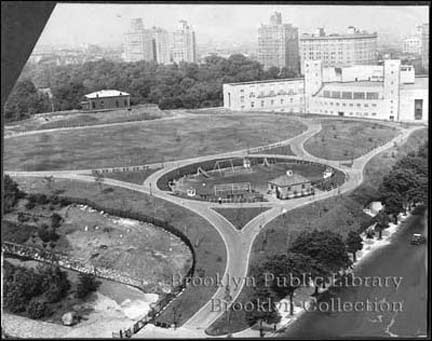
The idea, in short, was to give cyclists and carriages a smooth, scenic ride all the way from Coney Island to Prospect Park to Highland Park — the latter distance, of course, being from reservoir to reservoir also, as the land that today is just east of the Brooklyn Public Library was then Mount Prospect Reservoir. (A 1939 photo from the BPL collection shows this nicely.) It was hoped by planners that Highland Boulevard would be extended to Forest Park but disputes — often quite heated — with Cypress Hills Cemetery kept that from happening.
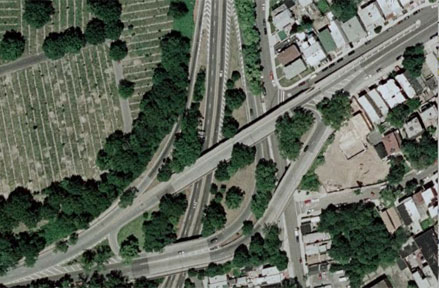
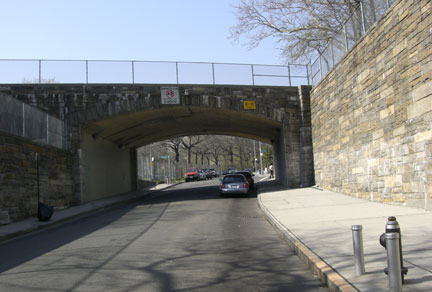
In any case, while a bit obscured today by the construction of the Interboro, the route went like this: Eastern Parkway to Eastern Parkway Extension to Bushwick Avenue, scooting around the border of Evergreen Cemetery to — ready?– Highland Boulevard, which traversed the then-rugged valley via this Vermont Street viaduct. It might not be impressive now but, the Daily Eagle reported, its 500 tons of steel made it one of the heaviest highway bridges of its time. Before the viaduct was complete, the preferred route was from Bushwick to Jamaica and then up the hill at Vermont — the opposite of what we’re doing here.
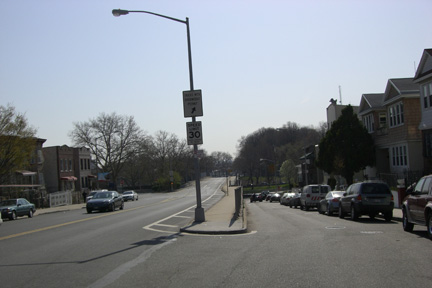
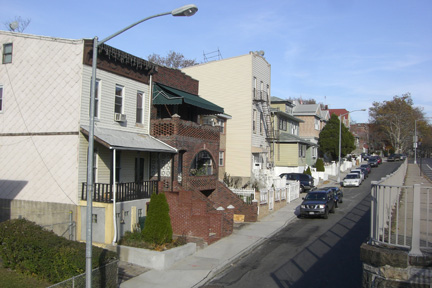
Although it’s one-way heading west, a lane of Highland still descends to Vermont. Crossing under the viaduct, we come upon another bridge, this one of modern design dating to the construction of the Interboro. There are two stone stairways between the bridge and Vermont Street, one of which is fenced off and abandoned. I’ve seen a jazz saxophonist practicing underneath here in Summer — perhaps for the acoustics, maybe to keep out of the sun — but, aside from noting the homes on the south side of Highland Boulevard which were razed to wake way for the bridge (some of the numerous small-scale losses even Robert Caro couldn’t cover in The Power Broker), there’s little to detain us from crossing under.
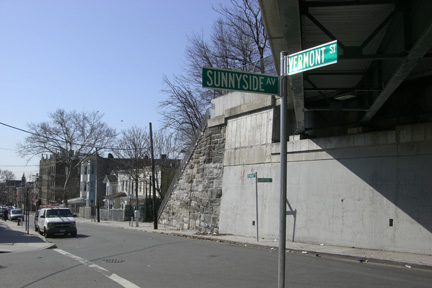
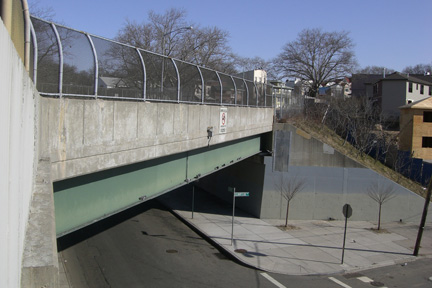
Highland Boulevard crosses over Sunnyside and Vermont
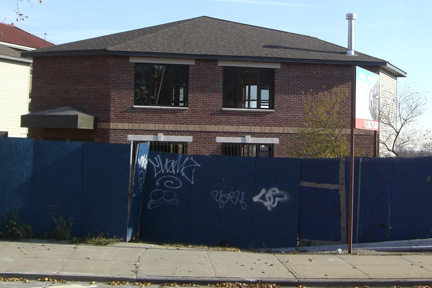
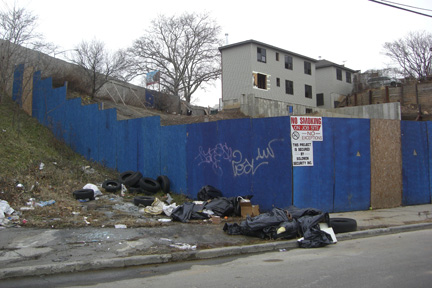
The block of Sunnyside between Vermont and Miller is a study in contrasts: a mix of detached houses and, recently, some new — and bizarrely protracted –construction of dubious craft courtesy of United Homes. Why dubious? Work would appeared to cease months at a time, while on the Highland Boulevard side, the facades of the units visible from the Jackie were hastily completed. While activity on the site picked up in Spring 2008, a corresponding aesthetic transformation — such as windows on the side — didn’t appear forthcoming.

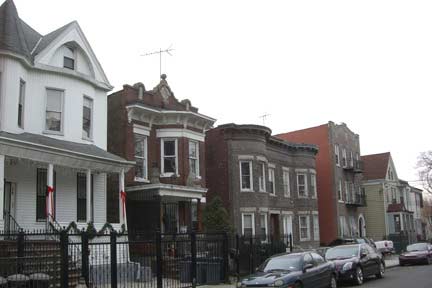
As hinted earlier, the rest of Sunnyside is very interesting, and in some ways a Brooklyn idyll of sorts. The homes along Highland Boulevard come down the hill in a tumble of stairs and retaining walls.
Things are more tightly packed on the other side of the street, almost comically so: how many different building styles can fit in a single block? Plenty.
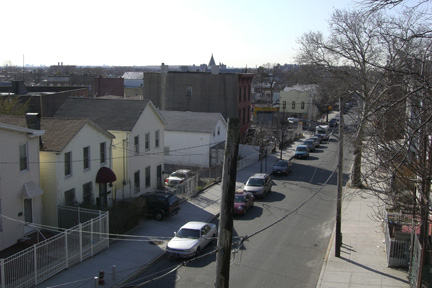
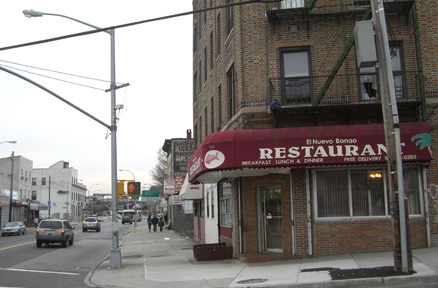
Dashing up the stairs we passed earlier, we survey the near-completion of our journey. East New York spreads across the horizon in all its plenitude. There’s even more than that, of course: the lives of the Dutch, English, African, Irish, German, Italian, Russian and Spanish-speaking peoples who have lived and labored in this part of the former 26th Ward. At Vermont and Jamaica, gazing west towards Brownsville and the jungle gym of Broadway Junction, is our final landmark: El Nuevo Bonao. The new what? Bonao is a mining city in the central highlands of the Dominican Republic, about 55 miles north of Santo Domingo, so its location here is apt. Appetite whetted: mondongo, Maestro, por favor!
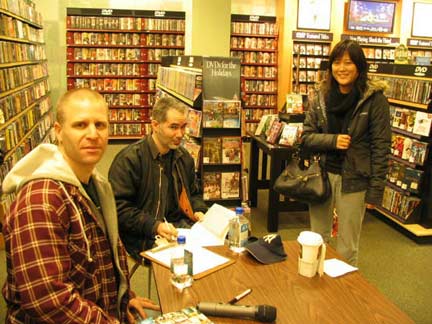
Brian Berger, Joseph Anastasio and Miru Kim
Brian Berger is the person most to blame for the all-city anthology, New York Calling: From Blackout to Bloomberg (Reaktion Books, 2007). He also writes for Stop Smiling magazine, is the publisher of whowalkinbrooklyn.com and still remembers the view of Playland from his grandparents’ apartment in Rockaway Beach.
The author would like to thank the Brooklyn Public Library, the New York Public Library, the East New York Project, brooklynballparks.com, Danny Lyon and the National Archive. Writing and photography: November 2007 through May 2008.
erpietri@earthlink.net
©2008

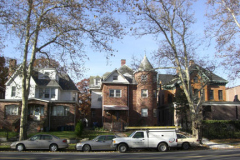
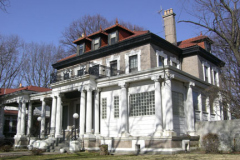
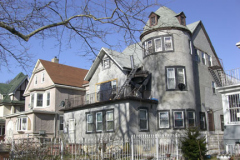
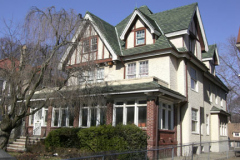

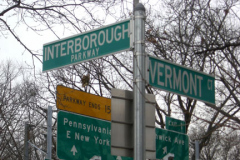

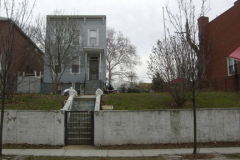
21 comments
Another strange thing about Robert St. is that, although it is a short street in a non-block numbered area, its few addresses are in the 2500-2699 range. I finally figured out the probable reason for this. All of the tax lots on Robert St. also front on Highland Blvd. Several maps from around 1900 show Eastern Pkwy Extension, whose numbers (and those of Pitkin Av) continue from Eastern Pkwy, as extending to Bushwick Av as it does today, but then turning right and continuing down what is now Bushwick Av. and onto Highland Blvd. A street guide from that era defines Barbey St. as beginning at “2584 Eastern Pkwy”, which is right where 2584 Robert St would be. Thus the strange numbers on Robert St.
Laurel Street could not have ever been built. The land on the south side of Highland Boulevard east of Barbey is held up by a series of retaining walls. These walls are in the exact same place as the fictitious Laurel Street would have been, had it existed. These retaining walls create the level acreage for the house built on the SE corner of Barbey and Highland (and some vacant land east of that, ending in the northwest corner of lower Highland Park). These walls can be seen rising from the backyards of the houses on the north side of Sunnyside Ave east of Barbey, and looming over the dead end on Sunnyside Court.
The same can be said of the land west of Barbey, retianing walls, rising from the backyards of Sunnyside Ave. homes, extend westward from Barbey Street to the apartment houses near Miller Ave. However there is no fictitious road on the map west of Barbey. There was an old service path for the mansions on the south side of Higland, starting on Barbey St. and running westward along the crest of the retaining wall, but this path became unserviceable back in the ’60s.
The northern terminus of Barbey Street is not on the same grade as Highland Bouleverd, an intersection with Highland (instead of the existing dead end) would have been a challenge to build. I also always suspected (having lived on Barbey for 18 years) that the northern-most hundred yards or so of the street was too unstable to support much vehicular traffic. The sidewalks on the east side of Barbey near the north end of the road plunged into the abyss (just around where the impossible Laurel Street would have been) back in the ’60s.
The former Anastasia M. Sasowski here…oh, how it breaks my heart that you did not include pictures of my childhood home, aka “The Haunted House”, at 356 Highland Boulevard. Yet it did my heart good to see the old Tartara house across the street from my home (you listed its picture as 39-Mansion-1), as well as the former Alba home at 279 Highland (40-Mansion-2) and the former Pfeifer house (aka the former home of Celie Trunz of Trunz Meats) at 283 Highland (40 xx Mansion 4). Here is a link to 356 Highland Boulevard, from approximately 1970: http://s75.beta.photobucket.com/user/Imperatrix62/library/356%20Highland
We the bonilla family been living in 267 highland blvd for 36 years.your information on Heath pl&Robert st is incorrect .We been using or driving threw Heath pl to Robert st to get to our garage right at the corner of both in the back of our home for 36 years the state law is after 10 years we have achieved an easement by prescription.This is the only way we can get to our garage we been doing so for 36 years.I know for a fact that everyone that lives or works in the area have seen us doing so year after year.Now the park administration want to close the reeonly way we can get to our garage.They are breaking a state law who or what gives them the right to denie us access to our property.Someone did not do there homework.
your info is not corret,heath pl&robert st is been use as entrance to the garage of 267 highland blvd for 36 years which is in the back.We have a easement by prescription and that’s the law.Now the park administration want to close it up and denie us access to our property.Who gives them right to break the law.
This brings back wonderful memories of home…. thank you.
I enjoyed your photo essay about Highland Park/East New York. I came to ENY at age 14 from rural New Jersey, when my mother was re-married a man who had a business in Brownsville. We lived in “Arlington Village” when it was brand new in 1948, on Atkins Avenue at Atlantic. I was a avid bicyclist, and rode all the streets in your photos, and especially loved the steep slope of Miller Avenue down to Jamaica Avenue. I also loved riding along Highland Blvd. and down Snake Hill back to Jamaica Avenue and back home along Highland Avenue to Atlantic. I attended Thomas Jefferson for 2 years, then transferred to Franklin K. Lane, graduating in 1952. I married in 1953 to a ENY boy who lived around the corner from me in Arlington Village. I lived in Brooklyn for all my married life, and after my husband died, I sold my home in Canarsie and moved to Staten Island, but I still enjoy all the photos of your presentation, bringing back many memories. Thank you.
that wasnt elderts lane station, it was actually cypress hills 🙂 loved this post
I grew up in Ozone Park right at the Brooklyn/Queens borderline. We called our area Cityline. My father’s office as well as the paternal side of the family all lived on the the Brooklyn side of the borderline and into East New York. My father was one of 6 children and we were 24 first cousins. My grandparents owned a few buildings on Atlantic Ave near Van Sciclen Ave. They moved to ENY from the Lower East Side. My fathers office was street level in one of their buildings. my grandparents lived above on the 2nd floor, and my aunt, uncle and cousins lived on the 3rd floor. Also there was a 3 family house on Ashford Street near Highland Park. Some of the newly married family would live on the first floor and remain till they had children, then it would be given to the next newlyweds. My dad’s sister and family lived on the second floor permanently, and my Uncle’s mother-in-law lived on the 3rd floor. Also we had some family living in the last house on the right where Schenk Court dead ends. Lastly some lived on Hill Street. When I was a a boy scout, sometime in the 1960’s, we played baseball in the park. We walked up Force Tube to the park from Hale Ave. On my mother’s side, her only sibling married a man that lived on Pennsylvania Ave. in the 1980’s, I would take the train to Broadway Junction and from there, for the scenery and exercise I would walk all the way home to 78th street and 10 Ave ….You might have guessed this article brought back a flood of memories. I always found this area interesting and mysterious in it’s isolation.Thank you so much. no one ever seems to mention this part of Brooklyn that is very unknown and overlooked.
361 Highland Blvd (current home of the Carmelites) used to be a Jewish community center. My great-grandfather who did all of the genealogy research had “Jewish Ctr.” and the address noted on the back of one of his Lithuanian books. I wonder why…
As a teenager we hung out on Force Tube Ave and Ridgewood Ave. Force Tube was not mecademized until sometime in the late 1970’s…mYbe early 89’s. It was a dirt road!
Paula , this is tTommy Gillen how are u doing . How is your brother Tony and Francis doing . Hope is all well
Does anyone know where snake hill rd is? There is supposed to be a WW1 memorial there. I believe there is a recognition plaque for a my relative and I would like to try to find it. Thanks!
Cypress Hills Street
Highland Blvd,
Wow that explains a lot of things to me. I was born in 1984 and lived in 90 Interboro pkwy as a child which turns into Vermont st going towards Jamaica Ave. But the Robert st theory is most definitely believable, the street now is actually I’m side of the original Highland Park and it would be a drive way from the back of the houses facing Highland Blvd. And Laurale St is definitely believable due to if u are coming down Highland Blvd east u will run into Barberry St which is Barbey St now, upon going down towards Jamaica Ave a little down the hill to the left is what looks like what could be a street which would be Laural St then next would be Sunnyside leading to Jamaica Ave going north. What is Force Tube now is clear to see that. I wish you would have actually shown the Reservoir because in thereos like another part of Highland Park which is amazing overseeing the what is now Jackie Robinson Pkwy and hills that led u to the Cemetery and down to Highland Blvd.
It was an amazing journey for me to now know about my home town
Just came across this now. Well done, Thank You.
My Family bought Our Home on Logan st in 1907
Oh, the stories we have.
I lived at 267 Highland Blvd from 1951 until I married in 1965. My parents were there until 1977. What a wonderful place to grow up. My neighbors were the Alba family
Such a great read! Enjoyed the historic details and all the photos. Born on Richmond Street just off Jamaica Ave. Married one of the Bolanda boys and moved to their family home on Hale Ave. which backed up on to Force Tube Ave. We grew up playing in Highland Park.Thanks for the memories!
Lived at 200 Highland Blvd. from 1945-63/64. Moved to 289 in 1970. Spent my youth in Upper Highland. Attended PS76,
JHS171 and FK Lane. Wonderful place to grow up. Highland Blvd. Snake Hil. Miller Hill, A park on your block(Lower Highland)
and across the street, Upper Highland. Worked at and met my bride at PS108. The boulevard is
now also called “Vito Batista Blvd”. Named in honor of Vincent’s (Vinny’s) father.
The boulevard was a mix of people with wide income ranges. My folks paid $49 per month for our 2 1/2 room apartment at 200.
220 was a step up from 200, but 224 was another level. Doorman, entrances on Highland Blvd. and Sunnyside Ave.
Some of the apartments had sunk in living rooms. The mansions were primarily owned by doctors. All of the kids played together,
no one checked bank accounts. Would love to hear from folks from that era.
I lived in the house at 289 Highland Blvd. In March 1960 I turned I turned 8 years old. That the same house that Ted Tushin lived in. It was a big house on a large lot. My brother was best friends with Vinny.